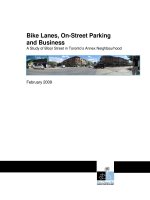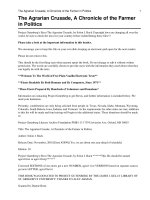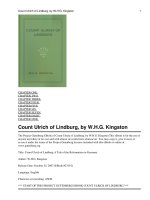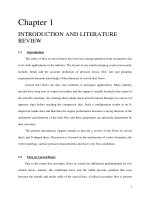A study of the flow in an s shaped duct 2
Bạn đang xem bản rút gọn của tài liệu. Xem và tải ngay bản đầy đủ của tài liệu tại đây (129.98 KB, 13 trang )
16
Chapter 2
EXPERIMENTAL SET-UP
2.1 Introduction
In this chapter, the details of the experimental set-up used in the present study are
described. A description of the S-duct wind tunnel test rig and the four different S-duct test
sections used in this investigation is described first. Next, all the instrumentation and
equipment used in experiments are presented. These include the measurement of side wall
surface pressure distribution, the use of a Pitot-static tube, a cross hot-wire and a 7-hole cobra
probe to measure the total pressure, and velocity components within the S-duct.
Subsequently, the different flow visualisation techniques used in the present study will be
presented. This is followed by the experimental set-up for flow control study using vortex
generator, tangential blowing and vortex generator jets. Estimated experimental errors are
stated.
The chapter concludes with a comparative study by benchmarking the present
experimental results with published data of Taylor et al. (1982b) and Sugiyama et al. (1994).
The bench marking establishes the accuracy of the present experimental method against
known data.
2.2. S-shaped Duct Wind Tunnel
An open loop suction wind tunnel was fabricated for this project and is shown in Fig.
2.1, with the square cross-sectioned S-duct as the test section. Flow velocities were U
m
= 5
and 15 m/s, thus giving Reynolds numbers, Re (based on the hydraulic diameter of the duct D
17
= 0.15 m) of 4.73x10
4
and 1.47x10
5
, respectively. A honeycomb and three sets of mesh were
installed at the inlet of the wind tunnel, followed by a contraction section with a contraction
ratio of about 12.
Three interchangeable S-duct test sections of different curvatures were used in this
investigation. Their geometry and dimensions are shown in Fig. 2.2. In reference to the first
bend, the vertical side walls are labeled as “Near-side” and “Far-side” walls and these names
continue onto the second bend despite the reverse in bend direction. The internal dimensions
of the square cross-sectioned S-duct measures D = 0.15 m and the overall length of the S-duct
test section is kept constant at L
O
= 0.8 m for all the three ducts under investigation. The test
section consists of a straight inlet and outlet section of length L
S
= 0.2 m (or L
S
/D = 1.333),
and the curved S-duct of length L
D
= 0.4 m (or L
D
/D = 2.666). For the given D and L
D
, the
offset between the inlet and outlet centerlines of the S-duct are 0.8D, 1.0D and 1.3D for Test
Section 1, Test Section 2 and Test Section 3, respectively. The corresponding curvature ratio
(R
C
/D) and flow turning angle () are R
C
/D = 2.422 and = 33.4
O
, R
C
/D = 1.933 and =
43.6
O
and R
C
/D = 1.667 and = 53.1
O
for Test Section 1, 2, and 3 respectively. The entire
test section is fabricated from transparent Perspex sheets, so that flow visualisation can be
conducted and viewed from the side and the top. The coordinate system used in this
experiment is shown in Fig. 2.3 and its origin is at the center of the inlet plane of the S-duct,
with the positive s-coordinate pointing downstream, along the duct centerline.
To compare the experimental results with available literature, a fourth square cross
sectioned S-duct test section (similar in geometry to that of Taylor et al. (1982a)) was tested.
This comparative study is to benchmark the experimental results with those available in the
literature. Referred to as Test Section 4, its geometry is shown in Fig. 2.4. It has hydraulic
diameter, D = 0.15 m, with a curvature ratio of R
C
/D = 7.0 and a turning angle = 22.5
0
.
Pressure taps were placed at mid height along each side wall of this test section. For this
18
comparative study, the test speed was 4.2 m/s and the Re = 4.0x10
4
. A boundary layer trip
was placed at the inlet of the test section to thicken the boundary layer to 0.15D as reported in
Taylor et al. (1982a). The measured data from this S-duct test section were compared to
corresponding data from Taylor et al. (1982a) and Sugiyama et al. (1997).
To measure the exit flow condition in the S-duct, a transverse slot was cut on the top
cover of the test section near the S-duct exit, so that different probes (Pitot-static and hot-wire
probes) could be inserted into the wind tunnel. A diffuser was installed downstream of the
test section and it is 2000 mm in length, with a half angle of 3.5
O
and an area ratio of 5.585.
The exit of the diffuser was connected to an axial fan, using a flexible canvas tube to
minimise vibrations from the fan transmitted upstream to the test section. The uncertainty in
the spatial measurement and probe position is about ± 1 mm. And the uncertainty in the flow
velocity measurement is about 1% at U
m
= 15 m/s. The inlet boundary layer thickness for a
flow speed of 15 m/s was 7.5 mm (or 0.05D). Error analysis is given in Appendix D of the
thesis.
2.3 Pressure Measurement
2.3.1 Side Wall Pressure Measurement
To measure the side wall pressure (P) distribution on the S-duct test section, 36
pressure taps were installed at mid-height of each vertical side wall. The pressure taps were
spaced 15 mm apart and their locations are shown in Fig. 2.3. All the pressure tubes were
connected to two pressure scanners, each with 48 ports and the pressure was measured using
two ±0.3 psid pressure transducers (Model PDCR23D from Scanivalve Corp.). Both the
pressure transducers were housed within a Scanivalve for computer controlled pressure
scanning/measurement. Each time the Scanivalve was switched to a new port, data
acquisition was delayed for about 5 sec to allow the pressure to stabilize. The pressure data
19
from each pressure tap was sampled at 2000 Hz for 10 sec. The reference wall static pressure
(P
S
) was measured by a ±0.1 psid Setra pressure transducer (Model 239). All data were stored
in a computer via an analogue-to-digital acquisition card (Model DT2838 from Data
Translation). The error in the measurement of the pressure coefficient is about 4%. The
pressure coefficient C
P
is defined as
2
2
1
m
S
U
PP
ρ
−
. Error analysis is enclosed in Appendix D of the
thesis.
2.3.2 Total Pressure Measurement
The total pressure distribution on the exit plane of each test section was measured
using a Pitot-static tube, mounted onto a computer-controlled linear traversing device. The
diameter of the Pitot-static tube measures 3 mm. A ±0.3 psid pressure transducer was used to
measure the total pressure (P
T
), while the ±0.1 psid Setra pressure transducer measured the
reference wall static pressure (P
S
). As shown in Fig. 2.1, the Pitot-static tube (near the centre
of the picture) extends into the test section through a transverse slot that was cut on the top
cover of the test section near the S-duct exit. The linear traversing mechanism translated both
horizontally (cross flow) and vertically and moved the Pitot - static tube at a spatial interval
of 5 mm. The entire exit plane was surveyed by the probe except for a 2.5 mm gap near the
four surrounding walls due to the probe’s finite size. Thus, the probe traversed from y/D =
z/D = -0.4833 to 0.4833. Each time after the probe was moved to a new position on the exit
plane, a 5 sec time delay was allowed for the flow to stabilize before sampling the pressure
data at a rate of 2000 Hz for 10 sec. The total pressure coefficient C
PT
is defined as
2
2
1
m
ST
U
PP
ρ
−
.
20
2.4 Single and Cross Hot-Wire Measurements
A single hot-wire (55P11 from Dantec) was used to measure the flow velocity and
turbulence intensity at the S-duct exit plane. It was mounted onto the linear traversing device.
The surveyed exit plane was the same as that made by the Pitot-static probe. Thus, the hot-
wire also traversed from y/D = z/D = -0.4833 to 0.4833 and at a spatial interval of 5 mm. At
each new position on the exit plane, a 5 sec time interval was allowed for flow to stabilize
before acquiring the hot-wire signal from the Constant Temperature Anemometer (Model
56C01). The signal was low pass filtered at 1.5 kHz before sampled at 3 kHz for 10 sec,
using the said computer and the analogue-to-digital acquisition card.
To measure the cross flow velocity at the exit plane, a rotatable cross-wires (55P61
from Dantec) probe was employed. The cross-wires and its probe support were mounted on
the linear traversing device. The diameter of the cross-wire probe is 5 mm. The cross-wires
probe was first orientated to measure the velocity components in the s-y plane at the duct exit
in the first pass. The experiment was then repeated with the cross-wires rotated 90
O
about its
own axis to measure the velocity components in the s-z plane. This enables the cross flow
velocity components in the y-z plane to be determined. Due to the larger probe size, the
velocity measurements could not be carried out within a 5 mm space around the interior side
walls. All cross-wire measurements were confined to a lower half plane of the duct exit, i.e.
from y/D = -0.4667 to 0.4667 and z/D = -0.4667 to 0.0 and at a spatial interval of 5 mm. Like
before, at each new probe position, a 5 sec delay precedes data acquisition. The two cross-
wire signals from the Dantec Constant-Temperature Anemometer (Model 56C01) were low
pass filtered at 1.5 kHz before being digitally sampled at 3 kHz.
The modified sum and difference method as outlined in Bruun (1995) was used to
decompose the effective velocity measured by each wire to the required velocity components.
This method requires the knowledge of the mean yaw angle (
i
_
α
) and the yaw coefficient
21
(
2
i
k
) of each wire which can be obtained through a yaw calibration of the crossed wires. Fig.
2.5(a) shows a typical result from a yaw calibration on the crossed wires at U
m
= 15 m/s. The
crossed wires were yawed at angles of
yaw
= -50
O
to 50
O
. The mean yaw angle of each wire
(
i
_
α
) is the angle at which it registers the maximum voltage. This is because at this angle, the
wire under calibration is normal to the flow, resulting in maximum loss of heat through force
convection, and hence yields a maximum voltage. Multiple yaw calibrations were performed
for this part of the work to obtain an accurate measurement of
i
_
α
for each wire.
To compute k
i
2
, Bruun et al. (1990) outlined a method as described below.
(a). A velocity calibration was carried out at
yaw
= 0
O
yaw angle at different flow
velocities (say U
m
= 5 to 20 m/s) to both wires. A best fit curve is applied to the calibration
curve (based on King’s Law,
(
)
n
m
n
iii
UkBAE
2/
2222
sincos
αα
++=
) which account for flow
angle
1
=
_
α
1
+
yaw
for wire 1 and
2
=
_
α
2
-
yaw
for wire 2 to obtain the unknown
coefficients of A and B for the two wires.
(b). A yaw calibration was then carried out at fixed flow velocity (say U
m
= 15 m/s) at
different yaw angles of
yaw
= -50
O
to 50
O
. At each yaw angle, the following ratio is
evaluated:
2or 1
sincos
sincos
2
2
2
2
2
2
/2
2
0
2
2*
=
+
+
=
−
−
=
=
i
k
k
AE
AE
E
iii
iii
n
yaw
yaw
yaw
αα
αα
θ
θ
θ
, (2.1)
which contains
2
i
k
,
i
α
and
i
_
α
but not B. Eq. (2.1) can be re-expressed as,
(
)
(
)
2or 1 sinsin11
222*
2
2*
=−−=− iEkE
i
i
i
yawyaw
αα
θθ
. (2.2)
Eq. (2.2) may be interpreted in the form of y = mx, and by plotting the above equation
as
(
)
1
2*
−
yaw
E
θ
versus
(
)
i
i
yaw
E
αα
θ
222*
sinsin −
and applying a curve fit to the data,
(
)
2
1
i
k
−
and
22
therefore
2
i
k
can be evaluated from the gradient. Fig. 2.5(b) shows a plot of Eq. (2.2) where
2
i
k
was evaluated to be 0.0708 and 0.0808.
With these known parameters, the velocity components can be obtained from the
modified sum and difference method (Bruun (1995)) based on the following equations,
[ ] [ ]
)()(
)( )(/)( )(/
2
2
1
1
1
1
2
22
2
2
1
11
αα
αααα
gg
gfVgfV
U
ee
+
+
=
, (2.3)
[ ] [ ]
)()(
)(/)(/
2
2
1
1
1
11
2
22
αα
αα
gg
fVfV
V
ee
+
−
=
, (2.4)
where
U = velocity component parallel to probe axis,
V = velocity component normal to probe axis,
V
ei
= effective velocity measured by wire i = 1 or 2,
f
i
= yaw function =
2/12
2
2
)sin(cos
iii
k
αα
+
, and
g
i
= yaw function =
i
iii
ii
k
k
α
αα
α
tan
)sin(cos
)1(cos
2
2
2
2
2
+
−
.
It is assumed that the values of
2
i
k
and
i
_
α
remain constant for each wire during the
experiment. However, an in-situ calibration of the cross-wire probe based on the King’s Law
was carried out for each wire at the start of every experiment to obtain the effective velocity
measured by each wire. The uncertainty in the flow velocity measurement using hot-wire is
due to the cumulative error from the measurement of velocity from the Pitot-static tube and
from other sources, and the error was estimated to be about 5% through multiple and repeated
readings.
23
2.5 Seven-hole Multi (Cobra) Probe
While crossed hot-wires were used to measure the cross flow velocity on the exit
plane of the S-duct., a seven-hole cobra probe, mounted on the linear traverse system, was
used to measure the same on the interior planes of the S-duct. This measurement system from
the Aeroprobe Corp. allows the measurement of the three dimensional velocity components
in the interior planes of the S-duct. Fig. 2.6(a) shows a detailed view of the seven-hole probe
with the associated probes axes, while Fig. 2.6(b) shows the complete cobra probe system.
The diameter of the cobra probe is 5 mm. Besides the probe, the system consists of a pressure
module (containing seven 0.3 psi pressure transducers), a DAQ board and an acquisition
computer. The pressure on the probe is measured by the pressure module via 7 tubes. The
analogue pressure signals are then digitized by the DAQ system board and transmitted to the
acquisition computer for storage into hard disk. A software called Aeroprobe supplied by the
manufacturer controls the data acquisition process. It allows the user to set important
parameters like the number of data points, the data acquisition rate, and external triggering
modes. In this study, 10000 data points are acquired at 1000 Hz for each probe position. To
synchronize the movement of the probe with data acquisition, an external trigger is applied to
start data sampling at every probe position. This external trigger is generated by another
computer that controls the linear traverse system. A more detailed explanation on the data
acquisition and control process is given in the next section.
2.6 Data Acquisition and Control System
The data acquisition system consists of a computer equipped with a DT 2838 Data
Translation Card. Voltage signals from pressure transducers and CTAs are connected to one
of the 8 channels for analogue-to-digital inputs. To control external devices (or events) like
the linear traverse for motion control, the Scanivalve for stepping of pressure ports or to
24
commence cobra probe’s data acquisition, 2 channels of digital-to-analogue TTL signal
outputs are available to trigger these devices. Fig. 2.7(a) to (c) show the schematic wiring
diagram used in the measurement of side wall static pressure, cross wire measurement and
cobra probe measurement respectively.
The drawings in Fig. 2.7(a) and (b) show that the data acquisition card is installed in
the Control Computer (as indicated). The inputs from the acquisition card receive voltage
signals from the respective pressure transducers and CTA, while the external devices like the
Scanivalve (Fig. 2.7(a)) and linear traverse system (Fig. 2.7(b)) are controlled by TTL trigger
signal outputs from the same data acquisition card. All data are stored in the hard disk of the
Control Computer. A slightly different wiring diagram is used in Fig. 2.7(c) for cobra probe
measurement. The Control Computer is solely responsible for controlling the linear traverse
and the commencement of data acquisition for the cobra probe via TTL trigger signals. This
Control Computer does not receive any data inputs from the cobra probe. All pressure data
from the cobra probe are stored and processed into velocity data using the Aeroprobe
Computer.
2.7 Surface and Smoke Flow Visualization
Smoke wire flow visualization was conducted on the inner wall of the first bend of the
S-duct to show and observe the presence of flow separation. Fig. 2.8(a) shows the
approximate location of the three smoke wires in the first bend of the S-duct. The flow
separation position was first determined from the measured side wall pressure distribution. In
the vicinity of the separation point, three 0.25 mm diameter smoke wires were threaded
through the pressure taps on the near and far side wall of the duct. The smoke wires stretched
across the width of the duct and were pull taut using weights. Paraffin oil was coated on the
wires with a small brush and beads of oil formed on the wire. With the application of an
25
electrical current, smoke streaks formed which enable flow separation phenomenon to be
seen.
Smoke wire flow visualization was also conducted close to the near-side wall of the S-
duct to visualize the flow near to that wall due to swirl development. In this case, the smoke
wire was stretched vertically and pulled taut using weights. The vertical smoke wire was
placed at about 2 mm away from the near side wall and upstream of the separation point, as
determined earlier from the side wall pressure distribution. The approximate location of the
vertical smoke wire is shown in Fig. 2.8(b). Both smoke wire flow visualization experiments
were conducted at 5 m/s, in order to coincide with the lower of the two wind speeds
investigated.
Surface flow visualization on the bottom wall (or floor) of the S-duct was conducted
to observe the flow pattern there. A thin, black plastic sheet was cut to fit the S-shaped duct
and placed on the bottom wall of each duct. Mixture of turpentine and white powder was
applied evenly onto the plastic sheet using a sponge. With the test speed set at 15 m/s, it took
approximately 30 minutes for the mixture to dry completely. The plastic sheet was
subsequently removed from the wind tunnel, and the surface flow patterns were captured
using a still camera.
2.8 Flow Control Devices
2.8.1 Vortex Generators
The vane-type vortex generators (VG) used in this study were made from 1 mm thick
aluminum sheet, and they are triangular in shape with a sharp leading edge. The general
dimensions are shown in Fig. 2.9(a). The height (h) of the VG was 5 mm and this
corresponds approximately to the boundary layer thickness of the flow at the duct inlet. A
row of 10 VGs were placed equi-distant to each other and pairs of VGs were angled towards
26
each other (or in a counter-rotating fashion) at an angle
vg
= 5
O
, 10
O
and 15
O
, as shown in
Fig. 2.9(a). A different vortex generator configuration is also shown at the bottom of Fig.
2.9(a) where the last pair of VGs at both ends of the row are angled at higher
vg
= 20
O
, with
the rest of the VGs remaining at 10
O
. This mixed VG configuration is to enhance further
mixing at the corner of the S-duct. The row of VGs was then placed vertically (in the z-
direction) on the near-side wall and just upstream of the separation point as determined from
the near-side wall pressure distribution. The placement of VG is shown in the 3D drawing of
Fig. 2.9(b). The most appropriate location was considered to be just prior to the region of
high adverse pressure gradients where the subsequent boundary layer rapidly grows
downstream.
2.8.2 Tangential Blowing
Fig. 2.10(a) shows a schematic set-up for tangential blowing on the near-side wall of
the S-duct. A frequency controlled blower supplies air into a plenum and the flow rate (Q)
was measured by a flow meter. To reduce flow unsteadiness, the air passes through a
honeycomb in the plenum before entering the 14 blowing tubes connected to the near-side
wall in the first bend. Each tube measures 1.5 mm and 1.37 mm in external and internal
diameter respectively and is bent at right angles to direct air to blow tangentially along the
near-side wall. Each blowing tube is also rotatable to blow air at an angle to the main flow.
The two photographs in Fig. 2.10(b) show the top and side view of the blowing tubes and
define the blowing angle,
blow
. As shown in the side view of Fig. 2.10(b), positive
blow
refers
to an angle where the jets are directed towards the top or bottom wall and negative
blow
refers to angle with jets directed towards the S-duct’s horizontal center-plane. In this study,
blow
varies from -5
O
, 0
O
, 5
O
, 10
O
, 15
O
and 20
O
, each at two different jet velocities of 12.5 m/s
and 24.5 m/s and at the test Reynolds numbers. At these blowing velocities, the respective jet
27
momentum coefficient, C
m
for each tube is 0.012 and 0.045. The small magnitude of the jet
momentum coefficient is due to the small blowing ports used here.
2.8.3 Vortex Generator Jets
Fig. 2.11 shows the set-up for vortex generator jets on the near-side wall. CNC wire
cut was used to fabricate the outlet angled slots of the vortex generator jets and these slots are
angled at
jet
= 5
O
, 10
O
, 15
O
and 20
O
to the flow. The row of outlet angled slots is cut from a
thin copper plate which measures 150 mm x 25mm x 0.1 mm (length x width x thickness)
and 7 pairs of VG slots are cut from each plate. The length and width of each slot is 15 mm
and 0.5 mm respectively. On the near-side wall of the S-duct, square cut-outs are removed
from the side wall and the vertical location of each cut-out correspond to the location of the
angled slot on the copper plate. The copper plate (with outlet angled slots at a particular
jet
)
is then placed over the square cut-outs. The angled slots of the VG jets are placed just
upstream of the flow separation point, as determined from the surface pressure measurement.
Similar to that of tangential blowing, tubes connected to the plenum direct air to the row of
VG slots and the air is injected into the S-duct on the near-side wall. The flow rate, Q was
measured by a flow meter and was varied (and hence the exit jet velocity) to match the jet
momentum coefficient, C
m
, of tangential blowing, which is 0.012 and 0.045.
2.9 Comparative Study with Existing Literature
This section describes a comparative study of the present experimental result with
those of Taylor et al. (1982a) and Sugiyama et al. (1997) for the S-duct test section of R
C
/D
= 7.0,
= 22.5
O
. The purpose is to benchmark our results with the existing published data to
ensure that the experimental facilities were working well. It can be seen from Fig. 2.12(a) that
the present surface pressure coefficients (C
P
) compare fairly well with those reported in
28
Taylor et al. (1982a). These C
P
were conducted using a micro-manometer; the same
technique used by Taylor et al. (1982a). There is a clear general downward and sinusoidal-
like trend in the Cp distribution. Fig. 2.12(b) shows the normalized exit velocity distribution,
which also compare well with the data from Taylor et al. (1982a) and Sugiyama et al. (1997).
At the near-side wall, a region of low momentum fluid exists in all three cases, and the
normalized exit velocity in the present investigation agrees quantitatively with the two
published studies. In Fig. 2.12(c), a comparison of the normalized cross flow velocity profile
at the duct exit with corresponding data from Taylor et al. (1982a) and Sugiyama et al.
(1997) also shows fairly good agreement. The shape of the cross flow velocity profile and
their magnitudes are comparable.
This comparative study demonstrates that the experimental technique used in this
investigation re-produces existing data well and gives confidence of its accuracy. Based on
the same experimental technique, the swirl development in the three high curvature, square
cross sectioned S-ducts were studied and the results will be discussed in the subsequent
chapters.









